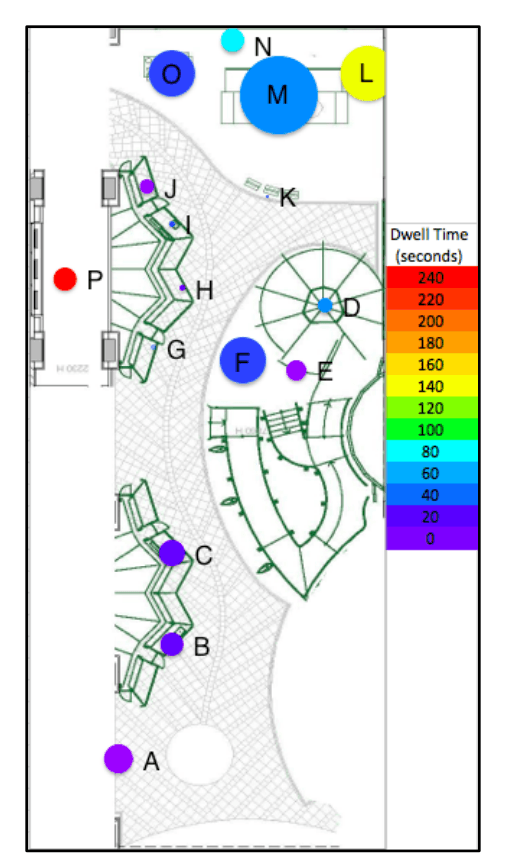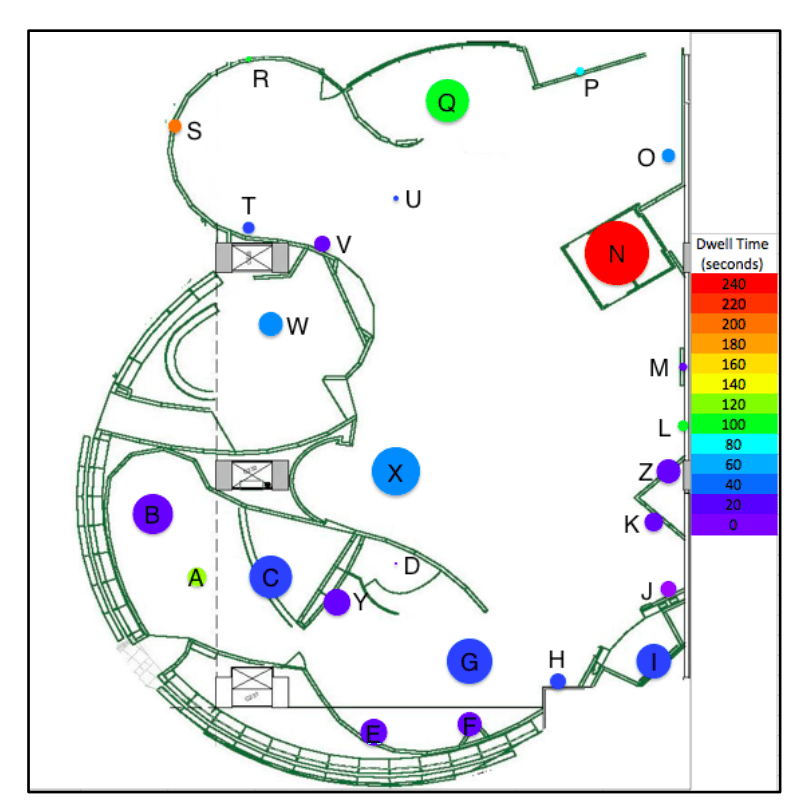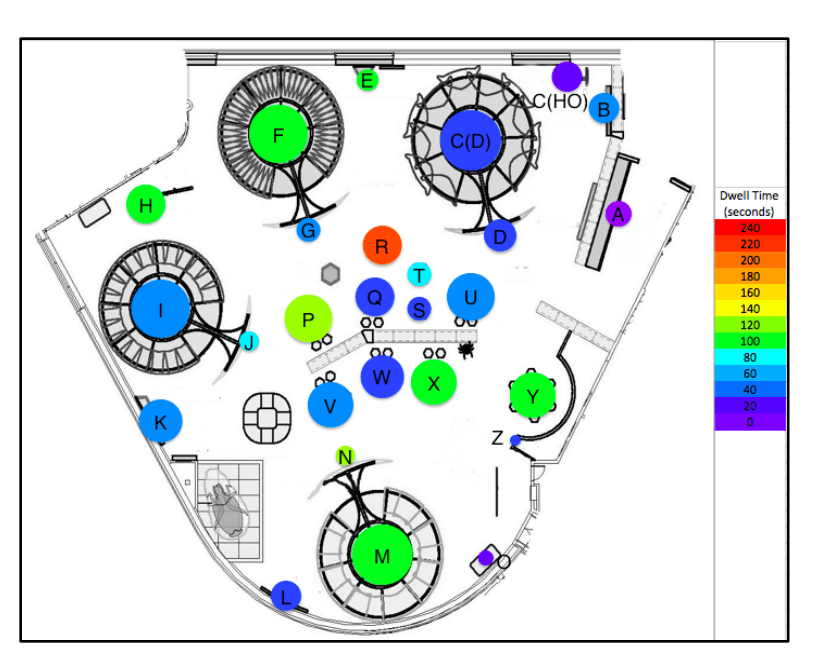Executive Summary
Introduction and Background
The mission of the Museum of New Zealand Te Papa Tongarewa is to embody and promote Aotearoa New Zealand’s rich diversity of culture, wildlife, and nature through community education and awareness. As part of this ongoing effort, the museum is in the process of thoroughly renewing the exhibitions that comprise its Natural Environment Zone. The renewed galleries will convey important lessons about the role humans play in caring for New Zealand’s natural environment by helping audiences feel a connection to nature and natural history. The goal of our project was to evaluate the visitor experience in the current Natural Environment Zone exhibits and develop recommendations for the renewal based on our findings.
Currently, the Natural Environment Zone consists of three distinct thematic sections called Mountains to Sea, Awesome Forces, and the temporary Bug Lab exhibition. These exhibitions are located in different galleries of the museum and focus on different aspects of the natural environment. Mountains to Sea showcases the biodiversity of Aotearoa New Zealand, showing the environments, animals, and plants that make the country so unique. It also houses the Colossal Squid, a more recent addition to the exhibition. Awesome Forces contains displays and interactives about natural phenomena such as earthquakes, volcanic eruptions, and tsunamis. Bug Lab is a temporary exhibition that will soon travel internationally. It showcases many different kinds of insects and arachnids, from the jewel wasp to the orchid mantis. This exhibit features many interactive elements to encourage visitor engagement and learning, and illustrates what Te Papa would like to achieve in the renewal of the Natural Environment Zone.
Museums in general have begun to incorporate more entertaining and interactive elements in their exhibits. A term called the “new museology” has emerged to describe how museums have become more visitor-centric and focused on engaging and educating the community (Davidson & Sibley, 2011). Evaluating the visitor experience has played a central role in efforts to make museums and exhibits more visitor centric. Evaluation is typically divided into formative and summative approaches (Screven 1990). We conducted a summative evaluation using tracking studies and exit interviews to gauge visitor satisfaction with different elements of the existing exhibits (Kelly, 2004; Walhimer, 2012).
Approach
Our first order of business was to tour the Natural Environment Zone as visitors and record our own experiences. We individually conducted a critical assessment of the content and design of the gallery based on personal observation. This allowed us to become more familiar with the content, design, and layout of the Natural Environment Zone.
To fully understand the intentions for each gallery, we conducted semi-structured interviews with some of the Science curators in charge of the galleries and exhibits in the Natural Environment Zone. We also interviewed Māori Studies curators about their wishes, perspectives, challenges, and goals for the renewal project.
To assess the visitor experience in the Natural Environment Zone, we used a combination of visitor tracking, observations, and exit interviews to gather data. This allowed us to combine many different data sets to inform our analysis of visitor engagement in the Natural Environment Zone. To obtain in-depth perspectives, we pursued conversation-based, semi-structured iii interviews with the visitors. These interviews were semi-structured with some prepared questions, but were ultimately guided by the flow of conversation with each visitor.
After our data collection, we analyzed the results from the observations and the interviews. We identified underlying themes, such as if visitors prioritized social interaction versus deeper engagement with the material. We compared these data across the three galleries that we analyzed to determine trends in popular interactives.
Findings
 Mountains to Sea contains mostly traditional museum elements, such as taxidermy, species indices, and text panels arranged around diorama cases. As we went through the exhibition, we noted many wordy labels with extensive descriptions, although many lacked Māori interpretations or translations. We found the Colossal Squid exhibit to be more noteworthy than the rest of the gallery, and we were excited to watch the video of the team that researched it, as well as engage with the touch screen that told more about the squid’s biology. After our site evaluation, we tracked visitors and noted their dwell times and behaviors at each exhibit within the gallery. We created a heat map of all of the noteworthy exhibits (see right), where the size of the circle indicates how many of those tracked visited the exhibit, and the color of the point reflects how long they stayed (i.e. ‘dwell time’). The dwell time is the average time that tracked visitors spent at each exhibit. From the 31 visitors that we tracked in Mountains to Sea, we found that they spent an average of 14 minutes in the exhibition. The most popular element was the Colossal Squid Display Tank (M), which attracted 27 out of the 31 tracked visitors.
Mountains to Sea contains mostly traditional museum elements, such as taxidermy, species indices, and text panels arranged around diorama cases. As we went through the exhibition, we noted many wordy labels with extensive descriptions, although many lacked Māori interpretations or translations. We found the Colossal Squid exhibit to be more noteworthy than the rest of the gallery, and we were excited to watch the video of the team that researched it, as well as engage with the touch screen that told more about the squid’s biology. After our site evaluation, we tracked visitors and noted their dwell times and behaviors at each exhibit within the gallery. We created a heat map of all of the noteworthy exhibits (see right), where the size of the circle indicates how many of those tracked visited the exhibit, and the color of the point reflects how long they stayed (i.e. ‘dwell time’). The dwell time is the average time that tracked visitors spent at each exhibit. From the 31 visitors that we tracked in Mountains to Sea, we found that they spent an average of 14 minutes in the exhibition. The most popular element was the Colossal Squid Display Tank (M), which attracted 27 out of the 31 tracked visitors.
After gathering this data, we pursued interviews with visitors to determine the more subjective aspects of the visitor experience. The squid again appeared to be the most popular attraction. Out of 31 interviews, 21 identified the squid as their favorite part. Five were fascinated by its huge size, 12 were drawn to it because it was so bizarre and the only one of its kind on display in the world, and 4 did not cite a reason. Many of these respondents were “browsing” and/or “killing time,” and admitted to not looking hard enough at the information provided in the exhibit. However, 11 of our respondents felt that they learned something about the squid during their visit.
Overall, Mountains to Sea was praised for its large variety of animals and accurate depiction of New Zealand wildlife. However, visitor interviews indicated that the exhibit is outdated and fails to meet Te Papa’s current vision. Most visitors noted that compared with other exhibitions, it was primarily factual and lacked emotional content.
Awesome Forces covers a range of topics, including tectonic plates, earthquakes, volcanoes, water levels, and the evolution of Zealandia. While we found all of these topics to be interesting, we noticed a lack of cohesion among the displays. There is such a diverse range of information, that it sometimes seemed disjointed and lacking in a logical or thematic flow.
After experiencing Awesome Forces fo r ourselves, we observed other visitors to note their interactions and dwell times at each exhibit (left). In Awesome Forces, 31 visitors were tracked, with 18 minutes being the average time spent in the exhibition. This average is influenced by an outlier in our data collection, who spent a total of 78 minutes in this gallery. Removing the outlier reduces the average time in the gallery to 16 minutes. The Earthquake House (N) attracted the most people, 24 of the 31 tracked visitors, and had the highest dwell time of 240 seconds.
r ourselves, we observed other visitors to note their interactions and dwell times at each exhibit (left). In Awesome Forces, 31 visitors were tracked, with 18 minutes being the average time spent in the exhibition. This average is influenced by an outlier in our data collection, who spent a total of 78 minutes in this gallery. Removing the outlier reduces the average time in the gallery to 16 minutes. The Earthquake House (N) attracted the most people, 24 of the 31 tracked visitors, and had the highest dwell time of 240 seconds.
Several visitors identified favorite exhibit elements in Awesome Forces based on reasons ranging from the level of interactivity to personal interest. However, 14 out of 31 visitors identified the Earthquake House as their favorite activity. Visitors also retained a variety of information when asked what they learned, including the movement of tectonic plates and how to prepare for an earthquake.
While we received very positive feedback from visitors, it was evident that visitors still felt that Awesome Forces needs renewing. One frequent Te Papa visitor specifically addressed this issue, citing some recent natural disasters that she would have liked to see in the gallery. Most visitors were tourists and came to learn about New Zealand earthquakes, but many felt underwhelmed. Another visitor suggested making the earthquake section more “in your face” because most countries do not experience earthquakes of New Zealand’s magnitude and cannot relate to the severity. When asked to compare Awesome Forces to other galleries, many had a personal interest or background in geology and preferred Awesome Forces for that reason.
The Bug Lab presents information about various types of bugs, including arachnids, myriapods, and insects. There are four large chambers, each with a dynamic display, three of which were created by Weta Workshop. These chambers give particular focus to the orchid mantis, the dragonfly, the jewel wasp, and the Japanese honeybee. We enjoyed how the bugs were personified and given storylines, since it added an extra layer of information that we could connect with. We were also pleased to see all of the learning material about how humans use characteristics of bugs to develop new technologies, such as drones and exoskeletons. Our team comes from an engineering background, so we were enthusiastic to see something that was relevant to our interests. We also found this exhibit to be extremely interactive, with touch screens, videos, hands-on activities, and opportunities for teamwork.
 We tracked visitors to determine which exhibits were the most popular and engaged visitors for the longest times (see right). In Bug Lab, we tracked 30 visitors and found that they spent an average of 35 minutes in the exhibition. The large displays attracted the most visitors, with both the Display Lab: Orchid Mantis Model (C(D)) and Swarm Lab (M) having 28 people enter. Similarly, 27 visitors entered Flight Lab (F) and Venom Lab (I). The Bug Debate (Y) appears popular from the heat map above, but out of the 21 visitors who stopped, only 3 actually completed the activity.
We tracked visitors to determine which exhibits were the most popular and engaged visitors for the longest times (see right). In Bug Lab, we tracked 30 visitors and found that they spent an average of 35 minutes in the exhibition. The large displays attracted the most visitors, with both the Display Lab: Orchid Mantis Model (C(D)) and Swarm Lab (M) having 28 people enter. Similarly, 27 visitors entered Flight Lab (F) and Venom Lab (I). The Bug Debate (Y) appears popular from the heat map above, but out of the 21 visitors who stopped, only 3 actually completed the activity.
The results of our study pointed to patterns in visitor expectation that can assist Te Papa in its renewal process. Much of our analysis revealed that efforts that have been adopted in the renewal project are headed in the right direction to enhance visitor engagement, while some exposed additional opportunities for innovation. Our evaluation also uncovered a wide appreciation for the museum and its enormous contribution to both local and international visitors. Based on our evaluation, we recommend the renewal team:
➢ Focus on topics that are unique and native to New Zealand;
➢ Continue to develop and maintain a connection between humans and the natural environment;
➢ Explore ways to integrate mātauranga Māori from the start of the exhibit development and design;
➢ Keep information concise and simple, and use digital labels to encourage more in-depth learning;
➢ Embrace the peculiar and bizarre aspects of the natural environment;
➢ Create detailed and eye-catching displays; consider more partnerships with Weta Workshop;
➢ Arrange the layout of the gallery so that valuable or costly exhibits are front and center;
➢ Incorporate hands-on games and activities for engagement with both children and adults; and,
➢ Encourage Māori Studies and Science curators to collaborate when developing content that relates to mātauranga Māori.
Overall, our evaluation of visitor experience has shown the full extent of visitor satisfaction and appreciation of Te Papa being an acclaimed national museum and international source of education. We are honored to have been able to contribute research and recommendations to further help Te Papa in its vision of Changing Hearts, Changing Minds, Changing Lives.


